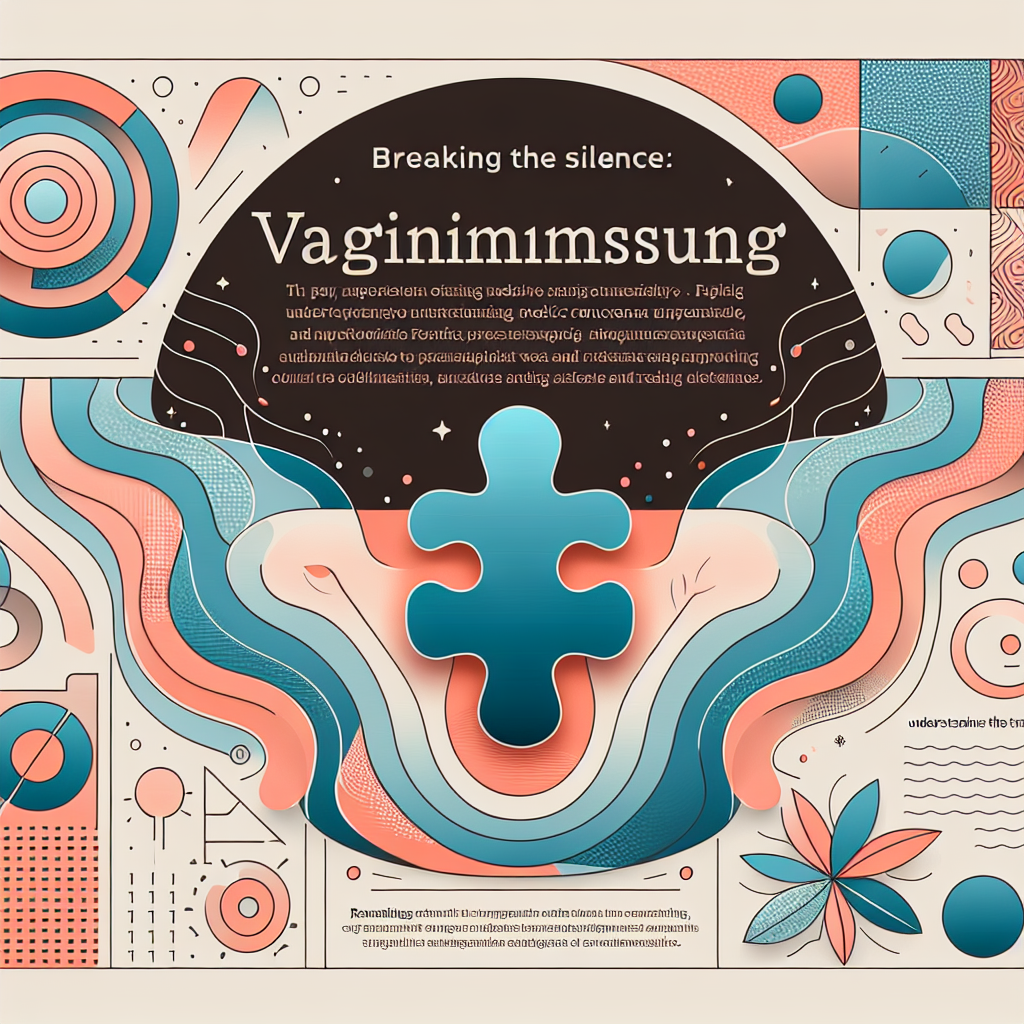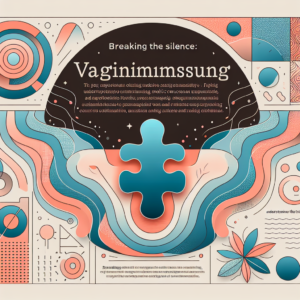Breaking the Silence: Understanding and Treating Vaginismus
Vaginismus, a condition often shrouded in misunderstanding and stigma, affects numerous women, hindering their sexual health and intimate relationships. Despite its prevalence, many suffer in silence due to embarrassment or lack of awareness. This blog post aims to shed light on vaginismus by delving into its symptoms, causes, and treatment options. We will also explore various therapeutic approaches available for overcoming this condition, highlighting the importance of a supportive and informed approach to managing vaginismus.
What is Vaginismus?
Imagine this: You’re getting ready for a relaxing evening, perhaps planning a cozy dinner or a movie night with your partner. But instead of feeling excited, you’re filled with anxiety and dread at the thought of intimacy. This scenario is all too familiar for women experiencing vaginismus, a condition that makes sexual intercourse not just difficult but sometimes downright impossible.
So, what exactly is vaginismus? In the simplest terms, it’s an involuntary contraction of the vaginal muscles that can cause discomfort, pain, and even make penetration impossible. This reaction isn’t something you can control with sheer willpower—it’s an automatic response much like blinking or sneezing. Surprisingly common yet frequently misunderstood, vaginismus turns what should be moments of intimacy into hurdles of distress.
The Mechanisms Behind Vaginismus
- Muscle Contractions: Often described as the body’s “fight or flight” mode kicking in at the most inopportune time, these involuntary muscle contractions serve as a protective barrier—though usually unnecessary—from perceived threats.
- Nervous System Role: The nervous system plays its part by sending signals that tighten the pelvic floor muscles whenever intercourse is anticipated.
If you’ve ever wondered about the prevalence of this silent issue, studies suggest it affects up to 1-7% of women globally. However, because it’s often kept under wraps due to embarrassment or stigma, these numbers are likely conservative.
The Emotional and Psychological Aspects
The mind-body connection is pivotal here. Women with vaginismus often report higher levels of anxiety related to intimate encounters. It’s a classic case of “the more you think about it, the worse it gets,” which exacerbates muscle tension and anxiety levels. According to psychologists specializing in female sexual dysfunctions, treating the psychological causes usually involves therapies like cognitive behavioral therapy and couples counseling. These sessions aim to untangle the emotional threads contributing to this physical manifestation.
Navigating life with vaginismus might feel overwhelming at times—but knowledge is power! Understanding your condition not only demystifies it but also empowers you to take actionable steps toward improvement and relief.
Recognizing Vaginismus Symptoms
Vaginismus, often cloaked in silence and misunderstanding, presents its own unique set of symptoms that can deeply impact a woman’s life and relationships. But what are these tell-tale signs that you or someone you know might be dealing with vaginismus? Let’s delve into the common indicators of this condition.
Common Symptoms of Vaginismus
- Painful Intercourse: One of the most prominent symptoms is pain during sexual intercourse, often described as a burning or sharp sensation. This pain can range from mild discomfort to severe agony, causing significant distress.
- Difficulty with Penetration: Women with vaginismus may experience difficulty or an inability to insert tampons, undergo pelvic exams, or engage in penetrative sex due to involuntary vaginal muscle contractions.
- Pelvic Pain and Discomfort: Persistent pelvic pain not directly related to intercourse can also be a symptom. This might manifest as an ache or pressure in the pelvic area.
- Anxiety Surrounding Intimacy: The mind-body connection is powerful. Women with vaginismus might experience heightened anxiety leading to anticipatory pain before attempting any form of penetration. This anxiety can exacerbate symptoms and create a cycle of fear and avoidance.
The Subtle Signs Often Overlooked
Apart from the more apparent symptoms, there are subtle signs that may go unnoticed but are crucial for diagnosis:
- Avoidance of Gynecological Exams: Some women might steer clear of routine gynecological exams due to discomfort or fear stemming from previous painful experiences.
- Tension in Pelvic Muscles: Chronic tension or tightness in the pelvic floor muscles may indicate underlying issues such as vaginismus. Physical therapy for vaginismus can offer relief through targeted exercises and relaxation techniques.
- Emotional Distress: Feelings of frustration, embarrassment, or shame associated with sexual activity are not uncommon and can add to the emotional toll on affected individuals.
If you recognize any of these symptoms in yourself or others, it’s important to remember that you are not alone. Vaginismus is treatable with proper guidance and care from specialists who understand this nuanced condition. For more information on related conditions that could impact your sexual health, visit our detailed page on various urologic conditions at renamalikmd.com/conditions.
Navigating through the maze of genital pain disorders like vaginismus requires patience and professional support. Remember, acknowledging these symptoms is the first step towards reclaiming control over your sexual health and well-being.
Exploring Causes of Vaginismus
Vaginismus, often shrouded in silence and misunderstanding, is a condition that requires deeper exploration to understand its multifaceted nature. The involuntary vaginal muscle contraction that characterizes vaginismus can be triggered by an intricate mix of physical and psychological factors. By unraveling these causes, individuals and healthcare providers can better navigate pathways toward effective vaginismus treatment.
Psychological Factors: More Than Just in the Mind
The intricate dance between mind and body plays a critical role in many sexual disorders, including vaginismus. Anxiety and vaginismus have a well-documented connection. Studies have shown that women struggling with anxiety may also experience increased vaginal muscle tension, leading to painful intercourse. Furthermore, past traumatic experiences, such as abuse or negative sexual encounters, can deeply ingrain fear-based responses during intimate moments.
- Anxiety: Heightened anxiety levels may lead to increased tension in pelvic muscles.
- Past Trauma: Experiences of sexual trauma can create a protective response where the body anticipates pain.
Physical Contributors: The Tangible Influences
While the mind’s influence is significant, physical aspects cannot be overlooked. Conditions such as pelvic inflammatory disease or endometriosis are known to exacerbate pelvic pain and discomfort. In some cases, previous surgeries or injuries to the pelvic area can also contribute to the development of vaginismus.
- Pelvic Health Issues: Conditions like endometriosis can increase pelvic pain sensitivity.
- Pelvic Floor Dysfunction: Tension or weakness in the pelvic floor muscles may result in uncontrolled contractions.
The Mind-Body Connection: A Symphony for Sexual Health
The phrase “it’s all in your head” might sound dismissive but understanding the mind-body connection is crucial. In fact, therapies that address both psychological and physical aspects have shown promising results. Cognitive Behavioral Therapy (CBT) for instance, helps individuals reframe their thoughts about intimacy while simultaneously introducing progressive muscle relaxation techniques for sexual pain relief.
A Case for Holistic Approaches
Imagine this: improving your gut health could enhance your sex life! A healthy gut means reduced inflammation which indirectly affects your overall well-being including sexual function (source). Holistic approaches consider every aspect of health when addressing conditions like vaginismus.
Tackling vaginismus involves peeling back layers of intertwined causes—both mental and physical. By acknowledging this complex interplay, sufferers can begin their journey towards overcoming vaginismus with a comprehensive treatment plan tailored to their unique needs.
Effective Vaginismus Treatment Options
When it comes to treating vaginismus, the good news is that there are a variety of effective options available, tailored to fit the unique needs of each individual. Understanding and addressing the root causes—whether physical, psychological, or a combination of both—is crucial for overcoming vaginismus. Let’s dive into the top treatment strategies that have proven beneficial for many women on their journey to reclaiming comfort and confidence in their sexual health.
Pelvic Floor Therapy
Pelvic floor therapy is often heralded as a cornerstone in treating vaginismus. This therapy involves exercises specifically designed to strengthen and relax the pelvic floor muscles, which can sometimes resemble an unruly group of toddlers during snack time—tense and altogether uncooperative. By working with a trained therapist, patients learn how to gain voluntary control over these muscles through biofeedback techniques and targeted exercises.
- A study published in the Journal of Sexual Medicine found that women who underwent pelvic floor therapy reported significant reductions in pain and improvements in sexual function.
- The use of vaginal dilators as part of therapy helps gradually desensitize the vaginal muscles to penetration, allowing for more comfortable sexual experiences over time.
Cognitive Behavioral Therapy (CBT)
Cognitive Behavioral Therapy is another potent ally against the trials of vaginismus. This therapeutic approach addresses any psychological factors contributing to involuntary vaginal muscle contractions by focusing on thought patterns that may fuel anxiety or stress related to intimacy. In essence, CBT helps rewire the brain’s responses—like a tech support call for your emotions.
- CBT has been shown to reduce anxiety associated with intercourse in numerous studies, enabling women to approach intimacy without fear.
- This therapy often includes education about anatomy and sexual health, debunking myths that may exacerbate anxiety surrounding intercourse.
Relaxation Techniques
No effective treatment toolkit would be complete without relaxation techniques aimed at easing both mind and body. These methods include progressive muscle relaxation exercises and mindfulness practices designed not just for yogis or those with an affinity for incense but for anyone looking to create a serene connection between mind and body.
- Progressive muscle relaxation encourages women to systematically clench and then release different muscle groups, including those pesky pelvic floor muscles.
- A study by the American Urological Association highlighted how regular practice of these techniques significantly reduced symptoms of sexual pain disorders like vaginismus.
If you’re navigating through these challenges—remember, you’re not alone! Consulting with specialists who understand both the emotional and physical aspects of female sexual dysfunction can be transformative. For more information on managing conditions similar to vaginismus or other related inquiries, explore our comprehensive resources on conditions managed by Dr. Rena Malik MD on her website.
The Role of Support in Overcoming Vaginismus
Breaking the silence surrounding vaginismus can be a daunting task, but finding support is a crucial step towards recovery. Whether it is through partners, therapists, or online communities, support plays an essential role in managing and overcoming this condition. Let’s dive into how the right support can make all the difference.
Understanding the Emotional Landscape
Vaginismus is not just a physical condition; it’s deeply intertwined with emotional and psychological factors. Anxiety, fear of pain, and intimacy issues often exacerbate symptoms. According to a study published in the Journal of Sexual Medicine, women with vaginismus reported significantly higher levels of distress compared to those without sexual pain disorders. Addressing these emotional components through therapy and open communication is vital.
The Power of Shared Experiences
A study in the BMC Women’s Health highlighted that peer support groups offer invaluable benefits for individuals dealing with genital pain disorders such as vaginismus. Sharing experiences helps reduce feelings of isolation and promotes understanding that you’re not alone on this journey. Online forums and local support groups can provide a safe space to discuss challenges and triumphs.
Therapeutic Support: A Multifaceted Approach
- Cognitive Behavioral Therapy (CBT): CBT has been effective in helping individuals reframe negative thoughts associated with intercourse-related activities. It focuses on changing thought patterns to reduce anxiety associated with sexual activity.
- Pelvic Floor Therapy: Working with a specialist can help address involuntary vaginal muscle contractions through exercises tailored to strengthen and relax pelvic muscles.
- Dilators: Used as part of physical therapy for vaginismus, dilators help gradually desensitize and stretch the vaginal muscles.
If you’re feeling overwhelmed by these options, fear not! Consultations with healthcare professionals like those at RenaMalikMD.com can offer personalized guidance tailored to your needs.
The Partner’s Role: Teamwork Makes the Dream Work!
Your partner’s understanding and patience are key ingredients in overcoming vaginismus. Couples counseling can facilitate better communication and help both parties work through intimacy issues together. Humor can also be an excellent tool—laughter might not cure everything, but it sure makes navigating tough times more bearable!
A Gentle Reminder: Compassion is Key
The path to treating vaginismus requires patience and compassion—for yourself and from your support network. Remember, each step forward is progress! And when setbacks occur (because they might), lean on your support system—friends, family, or experts—to guide you back on track.
Pioneering New Research & Holistic Approaches
In recent years, the understanding of vaginismus has expanded significantly, paving the way for innovative treatments and holistic approaches that go beyond traditional therapies. As we dig deeper into the world of sexual health, the complexities surrounding vaginismus become more apparent, calling for comprehensive strategies that address both mind and body.
The Science Behind Vaginismus
Research indicates that vaginismus is not solely a physical disorder but often linked to psychological factors such as anxiety and past traumas. A 2020 study published in the Journal of Sexual Medicine highlighted that around 80% of women experiencing vaginismus reported significant improvement after addressing underlying mental health issues through cognitive behavioral therapy (CBT) combined with physical interventions.
Holistic Treatment Modalities
- Pelvic Floor Therapy: This involves targeted exercises to relax the involuntary vaginal muscle contractions. Many specialists recommend using pelvic trainers to aid in this process. For more information on how pelvic training can enhance sexual health, check out our detailed guide on pelvic trainers.
- Dilators: Progressive desensitization using vaginal dilators is a cornerstone in treating vaginismus. This gradual process helps women overcome fear and discomfort associated with penetration.
- Mental Health Support: Counseling and therapy focus on addressing emotional triggers and building self-confidence in intimate settings. Couples counseling can also be beneficial in fostering open communication and reducing intimacy issues.
- Nutritional & Lifestyle Adjustments: Emerging evidence suggests a connection between gut health and overall sexual wellness. A balanced diet along with proper nutrition can potentially alleviate some symptoms of vaginismus by promoting general wellbeing. Explore more about this fascinating link between gut health and sex life in our article: Improving Gut Health for Better Sex Life.
A Mind-Body Connection
The journey towards overcoming vaginismus is as much about mental resilience as it is about physical recovery. Techniques like progressive muscle relaxation have been shown to reduce pelvic pain effectively by creating a state of relaxation that counteracts involuntary spasms.
The future looks promising with ongoing research focusing on novel therapies like biofeedback mechanisms and advanced shockwave therapy—originally designed for erectile dysfunction but increasingly explored for its potential benefits in treating female genital pain disorders.[1]
“As we continue to broaden our understanding of sexual disorders like vaginismus, it is crucial to embrace a holistic view that incorporates both medical innovation and emotional support,” advises Dr. Rena Malik.
[1] For insights into shockwave therapy’s potential applications beyond ED: Visit our comprehensive article on its mechanisms: Shockwave Therapy Insights.
Concluding Thoughts on Managing Vaginismus Pain and Enhancing Sexual Health
As we navigate the complex journey of managing vaginismus pain, it’s crucial to remember that this condition affects not just the physical but also the emotional and psychological facets of well-being. Often shrouded in silence, vaginismus is a challenge that many women face, yet few openly discuss. With an estimated prevalence of 0.5% to 1% among women globally, the impact it can have on sexual health and overall quality of life is significant.
One vital aspect of overcoming vaginismus involves a comprehensive approach that includes medical, psychological, and lifestyle interventions. It’s not just about stretching those pelvic muscles like they’re prepping for a yoga retreat; it’s about understanding the mind-body connection—a dynamic duo that even Batman would envy!
- Pelvic Floor Therapy: Engaging in targeted exercises with pelvic trainers can significantly aid in alleviating involuntary vaginal muscle contractions. A study published in the Journal of Sexual Medicine found that pelvic floor therapy improved symptoms for over 70% of participants experiencing vaginismus.
- Cognitive Behavioral Therapy (CBT): Addressing psychological causes such as anxiety or past trauma through CBT can enhance treatment outcomes. By reframing negative thoughts about intercourse, many women find relief from associated discomfort.
- Dilators: Using vaginal dilators progressively helps in desensitizing the region and reducing pain during intercourse-related activities.
- Relaxation Techniques: Techniques such as progressive muscle relaxation and mindfulness not only help in managing vaginismus symptoms but also improve overall sexual health.
An essential part of managing vaginismus involves both partners working together towards a common goal—restoring intimacy and enhancing sexual pleasure. Couples counseling can be an effective tool for addressing intimacy issues and ensuring both parties are on the same page regarding treatment goals.
The road to overcoming vaginismus is often paved with patience, diligence, and sometimes a humorous outlook on what may seem like an insurmountable hurdle. After all, laughter might just be the best medicine alongside medically proven treatments!
If you or someone you know is grappling with this condition, reaching out to specialized healthcare professionals who understand both the physical nuances and emotional complexities involved is crucial. For further insights into how to manage your sexual health effectively, do explore our resources on conditions related to low sex drive in women.







